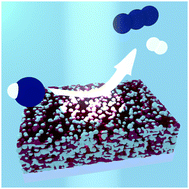A hybrid bulk-heterojunction photoanode for direct solar-to-chemical conversion†
Abstract
Organic semiconductors (OSs) are emerging candidates as light-harvesting materials in photoelectrochemical (PEC) cells for direct solar-to-chemical conversion. Despite significant recent progress with OS-based photocathodes, the development of efficient and stable OS-based photoanodes remains a challenge. Here, we demonstrate the concept of an in situ formed covalent polymer network (CPN) in a hybrid CPN:SnO2 bulk-heterojunction (BHJ) to increase the photocurrent density (Jph) and stability of OS-based photoanodes for PEC splitting of hydroiodic acid (HI). Our results indicate that the CPN:SnO2 BHJ overcomes the limited exciton diffusion length in OSs and provides a Jph improvement of more than three orders of magnitude compared to equivalent bilayer heterojunctions. Furthermore, insight into the operation of the hybrid BHJ in direct contact with aqueous electrolyte is gained with electrochemical impedance spectroscopy and PEC measurements under varying pH. With 1 M HI (pH 0) as the electrolyte, an optimized CPN:SnO2 photoanode without catalyst or protection layer delivers a Jph of 3.3 mA cm−2 at the thermodynamic potential of iodide oxidation (+0.54 V vs. the normal hydrogen electrode) and a continuous operation for 27 h (Jph loss of 12%), representing a new benchmark for OS photoanodes for solar-to-chemical conversion. Complete HI splitting is further demonstrated in an all-OS photocathode/photoanode PEC cell to produce H2 and I3− from simulated sunlight without applied bias.



 Please wait while we load your content...
Please wait while we load your content...